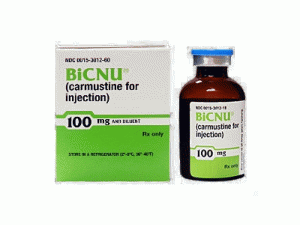卡莫司汀冻干粉注射剂(BICNU VIAL 100MG+DILUENT 3ML)
 产地国家:美国
处方药:是
所属类别: 100毫克+稀释剂3亳升/套
包装规格: 100毫克+稀释剂3亳升/套
计价单位:套
生产厂家英文名:HERITAGE PHARMACEUTICALS
原产地英文商品名:BICNU VIAL 100MG+DILUENT 3ML/KIT
原产地英文药品名:CARMUSTINE
中文参考商品译名:BICNU冻干粉注射剂 100毫克+稀释剂3亳升/套件
中文参考药品译名:卡莫司汀
产地国家:美国
处方药:是
所属类别: 100毫克+稀释剂3亳升/套
包装规格: 100毫克+稀释剂3亳升/套
计价单位:套
生产厂家英文名:HERITAGE PHARMACEUTICALS
原产地英文商品名:BICNU VIAL 100MG+DILUENT 3ML/KIT
原产地英文药品名:CARMUSTINE
中文参考商品译名:BICNU冻干粉注射剂 100毫克+稀释剂3亳升/套件
中文参考药品译名:卡莫司汀
简介:
部分中文卡莫司汀处方资料(仅次供参考) 中文药名:卡莫司汀注射剂 英文药名:BICNU (CARMUSTINE (BCNU)) 100MG 药品类别:限由医师使用BiCNU(卡莫司汀 carmustine)用于注射,用于静脉注射 最初的美国批准:1977年 警告:MYELOSUPPRESSION和PULMONARY TOXICITY查看完整的盒装警告的完整处方信息•抑制骨髓功能,特别是血小板减少症和白细胞减少症,是BiCNU最常见和最严重的毒性作用。监测血细胞计数。•来自BiCNU的肺毒性似乎与剂量有关。接受超过1400mg/m2累积剂量的患者的风险显着高于接受较少剂量的患者。 作用机制:卡莫司汀的作用机制尚不完全清楚。 虽然卡莫司汀烷基化DNA和RNA,但它与其他烷化剂不具有交叉抗性。 与其他亚硝基脲一样,它也可能通过蛋白质中氨基酸的氨基甲酰化来抑制几个关键的酶促过程。 代谢物可能有助于抗肿瘤活性和卡莫司汀的毒性。 适应症和用法:BiCNU是一种亚硝基脲,表示作为单一药物的姑息治疗,或与其他批准的化疗药物建立联合治疗,具体如下:脑肿瘤胶质母细胞瘤,脑干胶质瘤,成神经管细胞瘤,星形细胞瘤,室管膜瘤和转移性脑肿瘤。多发性骨髓瘤与泼尼松联合使用。复发或难治性霍奇金淋巴瘤与其他批准的药物联合使用。复发或难治性非霍奇金淋巴瘤与其他批准的药物联合使用。 剂量和给药:推荐剂量,作为单一药剂,每6周静脉注射150至200mg/m2BiCNU作为单剂量或连续2天分为每日注射75至100mg/m2。调整联合治疗剂量或骨髓储备减少的患者。仅在至少2小时内缓慢静脉输注给予重构溶液。 剂量形式和强度:用于注射:100mg卡莫司汀冻干粉末在单剂量小瓶中用于重建,小瓶含有3mL无菌稀释剂(脱水酒精注射液,USP) 禁忌症:过敏者禁用。 警告和注意事项:管理反应:可能发生外渗;在给药期间密切监测输注部位。 1、致癌性:可能对人类致癌。定期监测患者的这些症状,并告知患者他们需要寻求医疗帮助的症状。 2、眼部毒性:通过未经批准的动脉内颈动脉内给药途径发生。 3、胚胎 - 胎儿毒性:可导致胎儿伤害。告知女性生殖潜力可能对胎儿造成潜在风险并避免怀孕。 不良反应:最常见的不良反应(> 1%)是恶心,呕吐,肾毒性,肺炎,肺毒性,骨髓抑制。 药物相互作用: 1、西咪替丁:伴随使用增加骨髓抑制。 2、苯巴比妥:诱导卡莫司汀代谢,减少接触。可能导致疗效降低。 3、苯妥英:BiCNU可降低苯妥英的功效。 用于特定人群:哺乳期,建议哺乳期妇女不要母乳喂养。 储存:冰箱中(2°-8°C,36°-46°F)。稳定性将未开封的干燥药物小瓶存放在冰箱中(2°-8°C,36°-46°F)。将稀释剂小瓶存放在冰箱中(2°-8°C,36°-46°F)。未开封的BiCNU样品瓶的推荐储存可提供长达3年的稳定产品。英文版说明书:
BiCNU®(carmustine for injection)RECONSTITUTION / DILUTIONStabilityOnly use glass or polyolefin containers for BiCNU administration.Stability:The unopened vial of the dry drug must be stored in a refrigerator (2°-8°C, 36°-46°F). The diluent ampules may be stored at controlled room temperature (59°-86°F, 15°-30°C) or in a refrigerator (2°-8°C, 36°-46°F). The recommended storage of unopened BiCNU vials provides a stable product for up to 3 years. After reconstitution as recommended, BiCNU is stable for 24 hours under refrigeration (2°-8°C, 36°-46°F). Reconstituted vials should be examined for crystal formation prior to use. If crystals are observed, they may be redissolved by warming the vial to room temperature with agitation.Vials reconstituted as directed and further diluted to a concentration of 0.2 mg/mL in 5% Dextrose Injection, USP, should be stored at room temperature, protected from light and utilized within 8 hours.Dilution examples:[Dose < 20mg] [100ml ] [1 -2 hours][Dose 20 - 50mg] [250 ml ] [1 -2 hours][Dose > 50 mg] [500ml ] [1 -2 hours]Reconstitution:First, dissolve BiCNU with 3 mL of the supplied sterile diluent (Dehydrated Alcohol Injection, USP). Second, aseptically add 27 mL Sterile Water for Injection, USP. Each mL of resulting solution contains 3.3 mg of BiCNU in 10% ethanol. Such solutions should be protected from light.Administration:The reconstituted solution should be used intravenously only and should be administered by IV drip. Injection of BiCNU over shorter periods of time than 1 to hours may produce intense pain and burning at the site of injection.Infusion through a free-flowing saline or dextrose infusion, or administration through a central catheter can alleviate venous pain/irritation.High-dose carmustine: Maximum rate of infusion of leq3 mg/m2/minute to avoid excessive flushing, agitation, and hypotension; infusions should run over at least hours; some investigational protocols dictate shorter infusions. (High-dose carmustine is fatal if not followed by bone marrow or peripheral stem cell infusions)Note: double mouse click to return to the top of the pageWARNINGSBiCNU (carmustine for injection) should be administered under the supervision of a qualified physician experienced in the use of cancer chemotherapeutic agents.Bone marrow suppression, notably thrombocytopenia and leukopenia, which may contribute to bleeding and overwhelming infections in an already compromised patient, is the most common and severe of the toxic effects of BiCNU (see PACKAGE INSERT FOR WARNINGS and ADVERSE REACTIONS).Since the major toxicity is delayed bone marrow suppression, blood counts should be monitored weekly for at least 6 weeks after a dose (see PACKAGE INSERT FOR ADVERSE REACTIONS). At the recommended dosage, courses of BiCNU should not be given more frequently than every 6 weeks.The bone marrow toxicity of BiCNU is cumulative and therefore dosage adjustment must be considered on the basis of nadir blood counts from prior dose (see “Dosage Adjustment Table” under DOSAGE AND ADMINISTRATION).Pulmonary toxicity from BiCNU appears to be dose related. Patients receiving greater than 1400 mg/m2 cumulative dose are at significantly higher risk than those receiving less.Delayed pulmonary toxicity can occur years after treatment, and can result in death, particularly in patients treated in childhood (see PACKAGE INSERT FOR ADVERSE REACTIONS and PRECAUTIONS: Pediatric Use).CLINICAL PHARMACOLOGYAlthough it is generally agreed that carmustine alkylates DNA and RNA, it is not cross-resistant with other alkylators. As with other nitrosoureas, it may also inhibit several key enzymatic processes by carbamoylation of amino acids in proteins.Intravenously administered carmustine is rapidly degraded, with no intact drug detectable after 15 minutes. However, in studies with 14C-labeled drug, prolonged levels of the isotope were detected in the plasma and tissue, probably representing radioactive fragments of the parent compound.Itis thought that the antineoplastic and toxic activities of carmustine may be due to metabolites. Approximately 60% to 70% of a total dose is excreted in the urine in 96 hours and about 10% as respiratory CO2. The fate of the remainder is undetermined.Because of the high lipid solubility and the relative lack of ionization at physiological pH, carmustine crosses the blood-brain barrier quite effectively. Levels of radioactivity in the CSF are greater than or equal50% of those measured concurrently in plasma.INDICATIONS AND USAGEBiCNU is indicated as palliative therapy as a single agent or in established combination therapy with other approved chemotherapeutic agents in the following:1.Brain tumors—glioblastoma, brainstem glioma, medulloblastoma, astrocytoma, ependymoma, and metastatic brain tumors.2.Multiple myeloma—in combination with prednisone.3.Hodgkin’s Disease—as secondary therapy in combination with other approved drugs in patients who relapse while being treated with primary therapy, or who fail to respond to primary therapy.4.Non-Hodgkin’s lymphomas—as secondary therapy in combination with other approved drugs for patients who relapse while being treated with primary therapy, or who fail to respond to primary therapy.CONTRAINDICATIONSBiCNU should not be given to individuals who have demonstrated a previous hypersensitivity to it.DOSAGE AND ADMINISTRATIONThe recommended dose of BiCNU as a single agent in previously untreated patients is 150 to 200 mg/m2 intravenously every 6 weeks. This may be given as a single dose or divided into daily injections such as 75 to 100 mg/m2 on 2 successive days. When BiCNU is used in combination with other myelosuppressive drugs or in patients in whom bone marrow reserve is depleted, the doses should be adjusted accordingly.Doses subsequent to the initial dose should be adjusted according to the hematologic response of the patient to the preceding dose.The following schedule is suggested as a guide to dosage adjustment:Nadir AfterPrior Dose Percentage of Prior Dose tobe GivenLeukocytes/mm3 Platelets/mm3>4000 >100,000 100%3000–3999 75,000–99,999 100%2000–2999 25,000–74,999 70%<2000 <25,000 50%A repeat course of BiCNU should not be given until circulating blood elements have returned to acceptable levels (platelets above 100,000/mm3, leukocytes above 4,000/mm3), and this is usually in 6 weeks. Adequate number of neutrophils should be present on a peripheral blood smear. Blood counts should be monitored weekly and repeat courses should not be given before 6 weeks because the hematologic toxicity is delayed and cumulative.Administration PrecautionsAs withother potentially toxic compounds, caution should be exercised in handling BiCNU and preparing the solution of BiCNU. Accidental contact of reconstituted BiCNU with the skin has caused transient hyperpigmentation of the affected areas. The use of gloves is recommended. If BiCNU lyophilized material or solution contacts the skin or mucosa, immediately wash the skin or mucosa thoroughly with soap and water.The reconstituted solution should be used intravenously only and should be administered by IV drip. Injection of BiCNU over shorter periods of time than 1 to 2 hours may produce intense pain and burning at the site of injection.Preparation of Intravenous SolutionsFirst, dissolve BiCNU with 3 mL of the supplied sterile diluent (Dehydrated Alcohol Injection, USP). Second, aseptically add 27 mL Sterile Water for Injection, USP. Each mL of resulting solution contains 3.3 mg of BiCNU in 10% ethanol. Such solutions should be protected from light.Reconstitution as recommended results in a clear, colorless to yellowish solution which may be further diluted with 5% Dextrose Injection, USP. Parenteral drug products should be inspected visually for particulate matter and discoloration prior to administration, whenever solution and container permit.Important NoteThe lyophilized dosage formulation contains no preservatives and is not intended for use as a multiple dose vial.StabilityThe unopened vial of the dry drug must be stored in a refrigerator (2°-8°C, 36°-46°F). The diluent ampules may be stored at controlled room temperature (59°-86°F, 15°-30°C) or in a refrigerator (2°-8°C, 36°-46°F). The recommended storage of unopened BiCNU vials provides a stable product for up to 3 years. After reconstitution as recommended, BiCNU is stable for 24 hours under refrigeration (2°-8°C, 36°-46°F). Reconstituted vials should be examined for crystal formation prior to use. If crystals are observed, they may be redissolved by warming the vial to room temperature with agitation.Vials reconstituted as directed and further diluted to a concentration of 0.2 mg/mL in 5% Dextrose Injection, USP, should be stored at room temperature, protected from light and utilized within 8 hours.Glass containers were used for the stability data provided in this section.Only use glass containers for BiCNU administration.Important NoteBiCNU has a low melting point (30.5°-32.0°C or 86.9°-89.6°F). Exposure of the drug to this temperature or above will cause the drug to liquefy and appear as an oil film on the vials. This is a sign of decomposition and vials should be discarded. If there is a question of adequate refrigeration upon receipt of this product, immediately inspect the vial in each individual carton. Hold the vial to a bright light for inspection. The BiCNU will appear as a very small amount of dry flakes or dry congealed mass. If this is evident, the BiCNU is suitable for use and should be refrigerated immediately.Procedures for proper handling and disposal of anticancer drugs should be considered. Several guidelines on this subject have been published.1-8 There is no general agreement that all of the procedures recommended in the guidelines are necessary or appropriate.To minimize the risk of dermal exposure, always wear impervious gloves when handling vials containing BiCNU. This includes all handling activities in clinical settings, pharmacies, storerooms, and home healthcare settings, including during unpacking and inspection, transport within a facility, and dose preparation and administration.HOW SUPPLIEDBiCNU® (carmustine for injection). Each package includes a vial containing 100 mg carmustine and an ampule containing 3 mL sterile diluent.NDC 0015-3012-60STORAGEStore in a refrigerator (2°-8°C, 36°-46°F).用药温馨提示:当您服用此药物时,需定期接受医疗专业人士的检查,以便随时针对其药效、副作用等情况进行监测。本网站所包含的信息旨在为患者提供帮助,不能代替医学建议和治疗。
药品价格查询,专业药品查询网站,药品说明书查询,药品比价 » 卡莫司汀冻干粉注射剂(BICNU VIAL 100MG+DILUENT 3ML)
药品价格查询,专业药品查询网站,药品说明书查询,药品比价 » 卡莫司汀冻干粉注射剂(BICNU VIAL 100MG+DILUENT 3ML)





